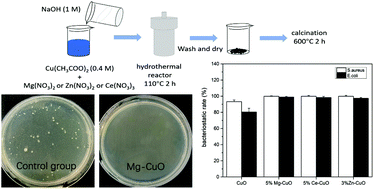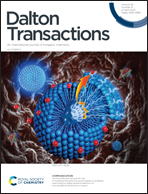Synthesis and evaluation of the structural and antibacterial properties of doped copper oxide
Abstract
Copper oxide (CuO) nanoparticles (NPs) doped with Mg2+, Zn2+ and Ce4+ ions were prepared by a hydrothermal method. SEM images revealed a spherical surface morphology for all doped CuO NPs. XRD patterns confirm that all doped CuO NPs exhibit a monoclinic structure at a dopant concentration of less than 7%, and when the doping content is up to 10%, MgO, ZnO and CeO2 phases are formed. ICP analysis indicated that these three doping elements have a promoting effect on the release of Cu2+ from the doped CuO NPs. Moreover, investigation of the antibacterial activity of the doped CuO NPs reveals that the doped CuO nanoparticles show effective antibacterial activity against Gram-positive Staphylococcus aureus (S. aureus) compared to the Gram-negative Escherichia coli (E. coli) bacterium. Among them, 5% Mg, 3% Zn and 5% Ce-doped CuO NPs exhibit the best bactericidal effect at a very low concentration of 0.05 mg mL−1, and the highest bacteriostatic rate can reach 99.9%. The improved antibacterial activity of the doped CuO NPs was attributed to the synergetic effect of ROS generation and the inactivation of proteins in the bacterial cells by the binding of the Cu2+ ions to the bacterial cell surface. This work highlights the potential of the doped CuO NPs to replace silver for antibiotic-free antibacterial applications in wound dressings, bone implants and dental fillings.



 Please wait while we load your content...
Please wait while we load your content...